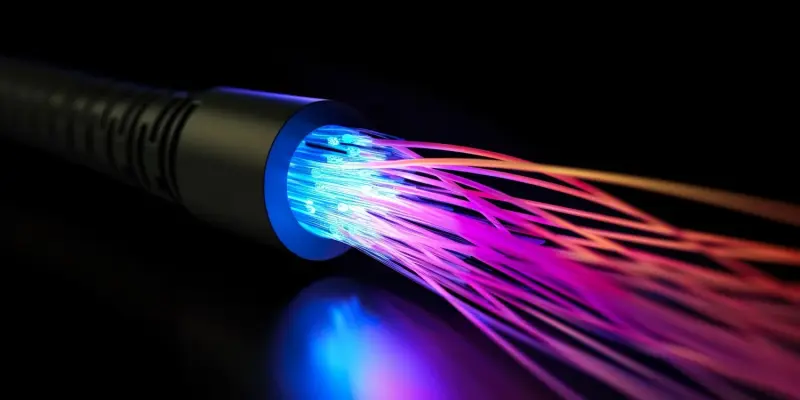The landscape of enterprise network infrastructure is undergoing a significant transformation with the introduction of Nokia’s Aurelis Optical LAN. This fiber-based solution is designed to meet the demands of modern businesses, ensuring connectivity that is both simplified and scalable, catered to the ever-evolving digital workspace. As industries lean toward sustainable solutions, the emphasis of Aurelis on decreased energy consumption and robust fiber infrastructure signifies an important shift away from traditional copper-based systems. By minimizing the reliance on copper, Nokia is ushering enterprises toward a more efficient and future-ready networking solution. Complementing this trend is the growing need for open architectures that support seamless integration of technologies, which Aurelis wholeheartedly embraces. The rollout of this new solution provides an overview of how businesses are expected to adapt to meet increasing demands and harness emerging technologies.
Redefining Connectivity Infrastructure
Embracing Sustainable Architecture
Nokia’s introduction of Aurelis Optical LAN represents a significant shift in enterprise networking, placing emphasis on sustainability and open architectures. By integrating fiber infrastructure that requires considerably less cabling—up to 70% less—this solution not only reduces the physical footprint of networks but also diminishes energy consumption by 40%. Such a reduction aligns with growing priorities for eco-friendly solutions in business environments, bridging the gap between technological advancement and environmental stewardship. Aurelis’ promise of a lifespan exceeding five decades further solidifies its potential to significantly cut the total cost of ownership, projecting savings up to 50%, thereby making it a financially sound investment for companies aiming for long-term growth.
Addressing Modern Networking Needs
As businesses seek reliable and sustainable network solutions, the transition from copper to fiber becomes increasingly attractive. This fundamental shift not only addresses current connectivity challenges but also ensures that networks can efficiently support future workloads. The scalability of Aurelis to accommodate speeds ranging from 1 Gb/s to 100 Gb/s empowers enterprises with the capacity to handle demanding applications, reinforcing its role as a critical component in the digital transformation of corporate infrastructure.
In today’s interconnected world, business networks must adapt to support a variety of high-bandwidth applications, including augmented and virtual reality systems. The ability of Aurelis Optical LAN to accommodate such needs makes it a vital asset for companies seeking to advance their digital proficiency. By ensuring compatibility with technologies like AI workloads and Wi-Fi 7, Aurelis helps organizations stay ahead of technological developments without necessitating constant infrastructure upgrades. Furthermore, the solution embraces open APIs, which ensure compatibility with existing IT ecosystems and align with industry shifts toward software-defined, interoperable network designs. This approach moves away from vendor-specific systems, offering enterprises greater flexibility and control over their networking architecture. In deploying this open-armed strategy, Nokia not only highlights its commitment to innovation but also provides a pathway for enterprises to future-proof their operations, accommodating ongoing technological evolution with ease.
Adoption Across Diverse Sectors
Versatility in Implementation
Nokia’s Optical LAN technology is not confined to a singular industry. Its widespread adoption is evident across 700 global locations, including sectors such as hospitality, healthcare, and education. The diversity in application underscores the robustness and adaptability of Aurelis, which has proven capable of supporting complex environments with ease. This passive optical network simplifies operations significantly while supporting substantial throughput and density—essential features for organizations navigating digital transformations. The deployment of Aurelis across various public and private sectors emphasizes its role in delivering consistent, low-maintenance connectivity. In environments like hospitals and universities, where reliable, high-performance networks are critical, Aurelis demonstrates an unparalleled ability to maintain service quality. By offering a flexible infrastructure solution, Nokia ensures that institutions can invest in a network system that grows with their evolving needs without incurring regular overhauls or disruptions.
Future-Ready Network Strategies
Emphasizing future-ready connectivity, Nokia’s Aurelis underscores the importance of a significant reevaluation of LAN infrastructure as businesses move beyond simply deploying faster Wi-Fi. The shift to fiber highlights a growing recognition that businesses must embrace comprehensive changes in their underlying networking systems to meet the demands of modern digital operations. By reducing reliance on copper, they’re preparing for a digital ecosystem that is durable and adaptable.
Strategically, Nokia positions itself at the forefront of networking advancements by providing Aurelis as a viable path forward for businesses seeking to enhance their competitive edge. The introduction of fiber-based solutions signifies not only an immediate upgrade but also a commitment to staying ahead of technological advancements. The shift toward sustainable and scalable network infrastructures reflects a broader trend in the tech industry, with Aurelis paving the way for enterprises to integrate transformative technologies seamlessly. The widespread deployment of this innovative LAN solution serves to affirm Nokia’s strategic position. It reinforces that modern enterprise networking requires both immediate and long-term considerations in accommodating technological demands.
Shaping Tomorrow’s Enterprise Networks
Nokia’s launch of the Aurelis Optical LAN marks a notable change in enterprise networking, emphasizing both sustainability and open architecture. By employing fiber infrastructure, this solution cuts cabling needs by up to 70%, thereby minimizing the network’s physical footprint and cutting energy consumption by 40%. This reduction is in tune with the rising demand for eco-friendly business solutions, effectively marrying technological progress with environmental responsibility. Aurelis boasts a lifespan of over 50 years, promising substantial total cost savings—up to 50%—making it a wise financial choice for companies aiming for sustainable growth.
As companies increasingly seek reliable and eco-friendly networks, moving from copper to fiber becomes ever more appealing. This change not only tackles current connectivity issues but also prepares networks for future demands. Aurelis can scale to support speeds from 1 Gb/s to 100 Gb/s, providing businesses the ability to manage demanding applications, confirming its pivotal role in the digital evolution of corporate infrastructure.

